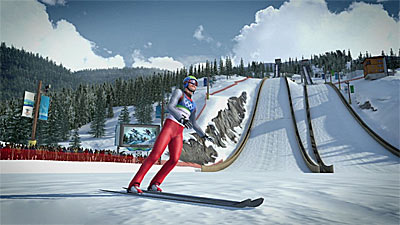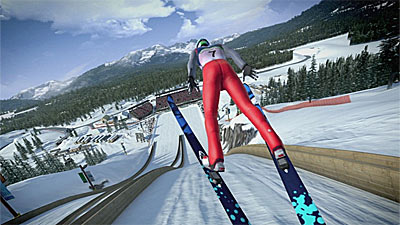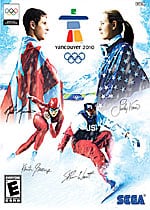Bronze
Let’s be honest with ourselves: the Winter Olympics are the diet Mr. Pibb of the sports world. They might resemble a somewhat more acceptable product, eg. the Summer Olympics, but even that can’t help distract from the fact that we’d rather be watching the playoffs of most any other professional sport. In the video game world this makes the development and purchase of a game based on the Olympic Games something of an anomaly.

Why make a game based on a property that struggles to find an audience for the actual event? At least in the US, this makes Vancouver 2010 an oddball especially for a publisher as venerated as SEGA. Even more puzzling: why would you strip a game marketed to a very particular audience of all the things said audience likely expected when they bought it?
That’s what the developer Eurocom managed to deliver in this interactive ode to snow sports. Vancouver 2010 is a very stripped down and rarely enjoyable game about an event that already has a considerably small following. The gameplay is, for the most part, uninspired, and the graphics are repetitive and the presentation is noticeably lacking. There are few bright spots in this blasé affair. I suspect that Eurocom, which has occasionally delivered solid gameplay (most arguably in the N64 Mortal Kombat days), put little effort into this one, and it shows.
The Winter Olympics consists of far more events than are represented here, and inexplicably, Eurocom has chosen to select a random assortment of 14 events, each of which can only be competed in the women’s or men’s division (another arbitrary decision). But this may be the least of the wrong turns as you could argue that selecting only a few events allows a focus on gameplay. Unfortunately, truth be told, gameplay is mostly just ok.
Most events use the right and left trigger to carve turns, the ‘A’ button to launch and start various meters and the left thumbstick to steer. It’s not really a complicated control scheme, and considering the actual sequence of actions you often have to perform, it’s a smart move on Eurocom’s part. The competitions come down to holding, releasing, and pressing any combination of these buttons to stick a landing, lunge for a finish line, jump out of a gate, or what have you. The ‘B’ button allows players to switch to a first-person view. This is a welcome addition and puts the player right into the middle of the action in a nice way, but it makes executing jumps and judging turns a bit more difficult. The controls are fairly intuitive to learn and they become easier with time, to the developer’s credit.

Among the events are probably some of the most recognizable competitions like Speed Skating, Freestyle Aerials, and Slalom. It doesn’t feel like there’s much variety in spite of the actual number of events. This may be due to the fact that there’s so little practical difference between some events like Skeleton, Bobsled, and Luge. The fact is there’s not much difference between sledding whether you go down face first, with a partner, or on your back.
The most interesting event is ladies aerials which requires all of the aforementioned timed button pressing but puts a twist on the completion of the trick routines. At the beginning of the run, players select the routine. When you jump off the ramp, a display pops up with a ball or pair of rotating balls on two concentric circular tracks with green and blue shaded sections, respectively. Gamers complete the routine by rotating the thumbsticks (each corresponding to one of the balls) to keep the balls within the two shaded segments. It’s an interesting concept. Easier tricks are fairly simple to pull off as the ball or balls rotate slower. The harder tricks require more dexterity and focus as you attempt to find an early rhythm and rotate the sticks, at times, in opposite directions. This is easily among the most challenging and fun events (and the best looking). It really forces you to think like a champion as you select your tricks, mixing a simpler trick with something more difficult to maximize your points.

The only problem I had was with the display, which surrounds your athlete mid air as time slows down. You become so enraptured in sticking the trick that you can’t actually watch what she’s doing. For a sports game this is critical, especially one without a manual replay option. Consider this: what if every time you were going to tackle someone in Madden you had to mentally freeze and glue your eyes to an onscreen prompt to deliver a solid hit, you focus all your energy on actually completing the movements and you succeed, but afterwards you just go onto the next play. You can hear the pop of shoulder pads and the crowd’s collective sigh, but you can’t really see the hit yourself. Unfortunately, this is a demonstration of Vancouver’s larger problem, even in its biggest successes it fails because, ironically enough, you feel too much like you’re actually an Olympic athlete. Shaun White doesn’t get to see himself do a tailgrab (unless he has a video camera) but he’s got a gold medal to show for it. Vancouver makes you work just as hard, for no reward, unless you like hearing the national anthem of Portugal.
Overall, gameplay reflects the incredible difficulty of being an Olympic athlete, and unmanageable turns at breakneck speed, overcompensating, etc. are the norm. This unforgiving curve means that most gamers won’t be earning a medal anytime soon. This game seems more suited for the Wii’s family-oriented slate. I suspect it may be easier to actually train for the Winter Olympics, at least there I wouldn’t ask myself why I was doing this to myself every two seconds.
I’m all for difficulty, but some things are just ridiculous. Ok, I understand the gamer should be punished, but how is it that missing a gate SLOWS me down? I skipped it to gain a few seconds. I imagine in real life these are the decisions athletes make; miss a gate and add a few seconds, but lose points. The give and take of the decision is naturally balanced by the point system. In Vancouver 2010, the game physically forces you to slow down, which is illogical and unnecessary.

‘Vancouver’ spreads it’s lackluster experience over three very basic game modes, and adds some online functionality and system link capabilities to extend the life of its ‘meh’ gameplay. Olympic mode allows you to stack events on top of each other, in any order you choose, to build your own games. Training mode is what it sounds like and Challenge mode tests your prowess by pitting you against unlockable pyramids of individual challenges for specific events-e.g. downhill runs at certain times, or maintaining a certain speed while passing through a gate in the slalom. Just like in the games, your best times are recorded in online leaderboards for users to compare (if you care). The courses are outfitted with tweaks that will alter your strategy slightly, such as snowmen that add more time in a timed run, but it’s not enough to distract from the fact that you’re still running the same courses and doing the same events. This is probably the most diverse mode, but it begs the question, if I couldn’t go 400 kilometers per hour in slalom to win first place in the Olympic Games, how could I do it in challenge mode? It feels kind of unnecessary.
Even in the inexplicable absence of gold medals, a full slate of events, or names on any of the competitors, presentation is the star of this game. You’ve got to play to understand how sad a statement that is. The competitors at times resemble characters in a Final Fantasy CGI film, music sounds like the Dance Dance Revolution Nagano Mix, and considering the fact that this is a next-gen game with 14 events set on limited tracks, the graphics usually leave a lot to be desired. Still, the developer does a solid job of capturing spatial relationships like height and distance along with speed, motion animations, and other aspects of the events themselves. It seems the most effort was put into the tracks and the competitors although for an HD system title, there’s nothing impressive here. I don’t doubt a Wii port could probably do the same things. Curiously, as a general rule night time events always look better and lighting effects are smoother.
My favorite touch overall comes after completing a timed event. A clear copy of your athlete appears on the track mimicking your earlier run. It’s a nice touch that makes it feel like you’re actually competing against yourself.
Thankfully, sound design is purposeful in Vancouver. The sound of skis slicing turns or crowds cheering are good enough, but the implementation of silence and ambient sound during jumps and tricks is probably the best thing about this presentation. I could swear I heard my competitor breathing as she twisted in the air. Of course, that is the moniker by which I am forced to call her since there are absolutely no names in this game and since I don’t work for ESPN, it seems like a strange step to me, though I imagine getting all those rights must have been hard.
Bottom-line: This is a game for completionists, leaderboard junkies, and glory hounds, though it should be noted that there are much simpler ways to proclaim one’s video game superiority. Almost every achievement in Vancouver 2010 is earned for gold medals, challenges, and online play. It definitely requires you to play a variety of modes and events to complete the game, but seriously, why? Anyone this into the Winter Games would be much better served shelling out the $60 bucks for snowboarding lessons.
RATING OUT OF 5 RATING DESCRIPTION 2.0 Graphics
Nothing to write home about. 3.0 Control
They don’t get in your way, and the ladies aerials is an innovative design. 3.0 Music / Sound FX / Voice Acting
Well directed during the actual events, but the music is for teenyboppers. Do teenyboppers still exist? 2.0 Play Value
You will have exactly as much fun as you had watching the last Winter Olympics. 2.5 Overall Rating – Average
Not an average. See Rating legend above for a final score breakdown.
Game Features:
